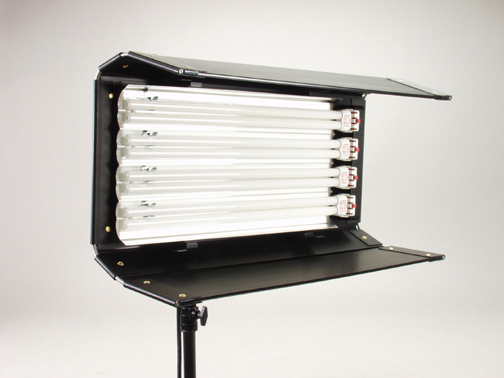DIY Flourescent Area Light
1 Disclaimer
This page is the result of the discussion that started on the apertus forums: http://www.apertus.org/forums/viewtopic.php?f=4&t=662
Currently it is a collection of information required to actually build one of these.
As always with DIY products that use electricity: be careful - don't kill yourself or your cast and crew - hands off if you don't know what you are doing!
2 Facts
2.1 General
- Normal fluorescent lights as they are used in buildings, parking lots, offices, etc. are unsuited as they flicker with twice the grid frequency (100/120 Hz) and this gives a pumping or flicker effect when shooting video. So what we need are high speed electronic flickering fluorescent tubes (35-45 KHz). At this frequency the flickering overlaps and this leads to a constant light flux with no noticeable fluctuations in light intensity.
- We need a fluorescent tube, an electronic controller (called ballast) and a starter (sometime integrated in the ballast).
- The ballast provides a high initial voltage to initiate the discharge, then rapidly limits the lamp current to safely sustain the discharge.
- There are 2 types of ballasts: Electromagnetic ballasts (strong flickering and humming audible noise) and electronic ballasts (high frequency = unnoticeable flickering, no audible noise) <- so this is the one we need: Wikipedia: Fluorescent lamps using high-frequency electronic ballasts do not produce visible light flicker, since above about 5 kHz, the excited electron state half-life is longer than a half cycle, and light production becomes continuous.
- Fluorescent ballasts are manufactured for three primary types of fluorescent lamps: preheat, rapid start, and instant start.
- Only "rapid start mode" ballasts are suitable for dimming
- Dimming might change the color temperature of the light (depending on tube quality)
2.2 Tubes
Tubes that some DIY cinematographers are already using:
- Osram Dulux L 55w 930 (Tungsten)
- Osram Dulux L 55w 954 (Daylight)
These cost around 6 - 20€ each and are easy to source locally.
Dulux L lamps are specially designed for television studio lighting. They provide high lumen packages and offer excellent color stability, even when dimmed down to 50%. The special phosphor allow them to seamlessly blend in with the light from other tungsten (warm) or metal halide (daylight) lamps on the set. The first number (in 930 & 954) is the color rendition level. 9 = 90%+ color rendition fidelity (see http://en.wikipedia.org/wiki/Fluorescent_lamp#Color_rendering_index). Kino were the first to manufacture tubes with this 95+% color rendition fidelity which might be even better than the one by Osram outlined here. Note that you can buy those kinoflo tubes "spare part" also, in the same price range (http://www.filmandvideolighting.com/2ft55tub6pac.html) - though we do not know if the Kinoflo ballast treats the tubes in a special way that enables/improves their performance.
2.2.1 Tube designations
When you research fluorescent tubes you will immediately stumble over designations like T8, T5 or T12.
Quite simply, "T" is the diameter of the tube. A T12 bulb will have a diameter of 12/8" (3.81cm).
Typically the more narrow the lamp, the more efficient and the more expensive it will be. Different designations also use different socket types (from http://en.wikipedia.org/wiki/Fluorescent-lamp_formats):
| Designation | Tube diameter | Extra | |||
|---|---|---|---|---|---|
| (in) | (mm) | Socket | Notes | ||
| T2 | 1/4" approx. | 7 | WP4.5x8.5d | Osram Fluorescent Miniature (FM) tubes only Havells Sylvania Luxline Slim T2 Linear | |
| T4 | 1/2" | 12,7 | G5 bipin | Slim lamps. Power ratings and lengths not standardized (and not the same) between different manufacturers | |
| T5 | T16 | 5/8" | 15,9 | G5 bipin | Original 4–13 W range from 1950s or earlier. |
| T8 | T26 | 1 | 25,4 | G13 bipin/single pin/recessed double contact | |
| T9 | T29 | 1 1/8" | G10q quadpin contact | Circular fluorescent tubes only | |
| T10 | 1 1/4" | G13 bipin | |||
| T12 | T38 | 1 1/2" | G13 bipin/single pin/recessed double contact | not as efficient as new lamps | |
2.3 Ballast
- Dimmable ballasts are in general more expensive (50-90€) than non dimmable ones (20-30€)
- The ballast needs to match the watts of the used fluorescent tube
- Some ballasts can supply 2 fluorescent tubes (indicated with markings like "2x58W")
- The Osram ballasts matching the Dulux L series are called T8 high frequency electronic ballast: QUICKTRONIC
- The Oscram Quicktronic dimmable ballasts have a digital interface (called DALI) that lets you control the lamps electronically: http://en.wikipedia.org/wiki/Digital_Addressable_Lighting_Interface <- Arduino based wireless light control over bluetooth anyone?
3 Energy Efficiency
Everyone talks about LEDs recently and how they are going to replace traditional light bulbs.
But lets take a look at the facts:
3.1 The Theory
Wikipedia: http://en.wikipedia.org/wiki/Luminous_efficacy
The luminous coefficient is luminous efficiency expressed as a value between zero and one, with one corresponding to an efficacy of 683 lm/W.
So the maximum physically possible output of one Watt of electric power are 683 Lumens of light. Depending on this efficiency the rest of energy is converted to heat rather than photons/light.
| Lamp Type | Luminous Coefficient |
|---|---|
| Candle | 0.04% |
| Tungsten Incandescent Bulb | 2 - 3% |
| Tungsten Halogen | 2.5 - 3.5% |
| LED | 0.7 - 15% |
| Fluorescent Tube | 9 - 15% |
| HMI | 9.5 – 17% |
So Fluorescent Tubes are just as energy efficient as LEDs and have been around for quite some time already.
